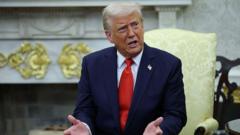In a move reflective of both economic strategy and political uncertainty, the Federal Reserve has lowered its key interest rate to between 4.5% and 4.75%. This decision represents the second consecutive cut, indicating a cautious optimism about stabilizing price increases. Starting in September, the Fed has effectively reversed its previous trend of rising rates — a response initiated to combat soaring inflation which had reached over 9% in mid-2022.
US Federal Reserve Lowers Interest Rates Amid Political Uncertainty Surrounding Trump

US Federal Reserve Lowers Interest Rates Amid Political Uncertainty Surrounding Trump
The Federal Reserve has taken action to mitigate economic concerns by cutting interest rates following Donald Trump's presidential election victory.
Market analysts had anticipated this rate cut; however, they remain wary about potential complications stemming from Trump's proposed economic policies, including tax cuts, immigration reforms, and tariffs. Concerns have been raised that these could exert upward pressure on inflation and increase government borrowing needs. This uncertainty has already prompted a rise in interest rates pertaining to US debt.
The adjustment in the Fed's interest rate is particularly significant, as it functions as a benchmark for lending across various sectors, including credit cards, mortgages, and loans. Following a history of rate hikes, the latest reduction by 0.25 percentage points suggests a response to the more favorable inflation figures, which have shown improvement but still linger above the target set by the Fed.
Despite acknowledging some progress in controlling inflation, officials from the Fed emphasized their commitment to maintaining stability in both prices and the job market, reaffirming concerns raised in their previous meetings.
As the economic landscape shifts, global markets will likely remain on edge regarding how Trump’s administration will impact fiscal policy and further interest rate decisions in the near future.
The adjustment in the Fed's interest rate is particularly significant, as it functions as a benchmark for lending across various sectors, including credit cards, mortgages, and loans. Following a history of rate hikes, the latest reduction by 0.25 percentage points suggests a response to the more favorable inflation figures, which have shown improvement but still linger above the target set by the Fed.
Despite acknowledging some progress in controlling inflation, officials from the Fed emphasized their commitment to maintaining stability in both prices and the job market, reaffirming concerns raised in their previous meetings.
As the economic landscape shifts, global markets will likely remain on edge regarding how Trump’s administration will impact fiscal policy and further interest rate decisions in the near future.





















